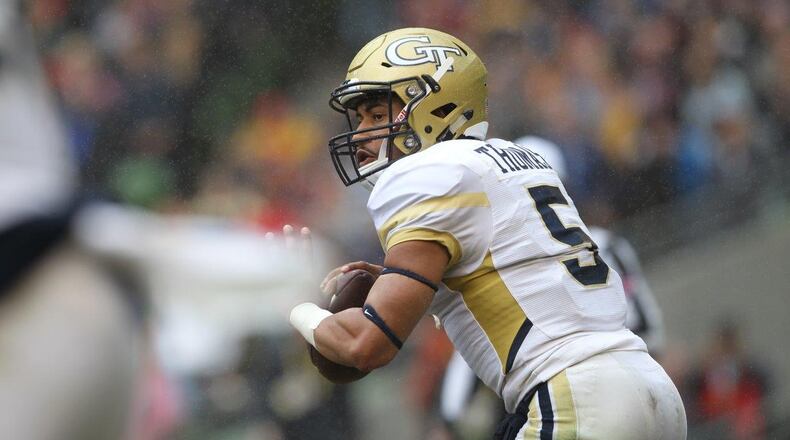In his team’s loss to Pittsburgh, Georgia Tech quarterback Justin Thomas had his highest passing efficiency rating game in his career for a start against a power-conference opponent. It is part of the evidence to Thomas that the Yellow Jackets offense is finding its form, a potential strength that could generate a turnaround in the second half of the season.
“I think just as an overall, last week was probably one of our better games, just running the ball and receivers making plays, just different things like that,” Thomas said. “For the offensive side, we’ve got to keep doing what we’re doing, making plays and continuing to keep getting better.”
Thomas completed seven of 10 passes for 130 yards and a touchdown, good for a rating of 212.2. His previous high for a starter against a power-conference team was a 209.1 rating against North Carolina in 2014, one of the team’s most efficient offensive performances in coach Paul Johnson’s tenure. Thomas’ rating in the Pitt game would have been even higher but for two drops. Among the highlights were on-the-spot throws into tight coverage to receivers Ricky Jeune and Brad Stewart for a 31-yard touchdown and a 27-yard third-down conversion, respectively.
“I think that we did a much better job of protecting him a week ago, and when you protect him and he can get where he can see, he’s a pretty accurate guy,” Johnson said.
The Tech offense averaged 6.7 yards per play against Pitt, above the Panthers’ season average of 6.1, and also didn’t fumble once for the first time this season. In the previous game, the loss to Miami, the Jackets averaged 5.0, above the Hurricanes’ season rate of 4.0 yards per play.
Thomas’ completion percentage – 51.3 – is the same as his All-ACC season in 2014, although his yards-per-attempt rate is down from 9.2 yards per pass to 7.4. It’s a reflection of the big-play capacity of his receivers in 2014, DeAndre Smelter and Darren Waller, and perhaps the effectiveness of the running game that opened up more downfield shots.
In his career as a starter, Thomas’ rate of 20-yard pass plays per attempt has been fairly steady at about one out of every eight throws, but his frequency of 40-yard pass play is lower this season. He had nine 40-yard completions in 203 attempts in 2014. He has one thus far in 85 attempts, the 81-yarder to Marcus Marshall to open the Vanderbilt game.
His success without Smelter and Waller is indicative of a quarterback who is developing his intermediate passing game and feeling more comfortable with the protection. His completion percentage is almost 10 points better than it was last year.
“Just being able to stay in there, and knowing I don’t have to run around to make plays – just staying in the pocket, being able to set my feet is helpful,” Thomas said.
From the standpoint that he doesn’t have receivers as dynamic as Smelter and Waller, the case can be made that Thomas is playing at his career peak. Tech does not keep records for interception percentage, but Thomas could finish among the best with one interception in 80 attempts thus far. The one interception was a desperation throw late in the game against Miami.
In 1959, Fred Braselton threw 64 passes with one interception, which is the lowest single-season rate for passing yardage leaders going back to 1950.
“It can get better, but I was pretty accurate in high school, also,” Thomas said. “It never stops.”
Tuesday, Johnson stressed the need to keep the passing game viable. One problem in the losses to Clemson and Miami was leaky protection in 3rd-and-long situations. That the Jackets have only half a season to avail themselves of such a dangerous asset makes protecting him all the more pressing.
“What we need to be able to do, if everybody’s up on the line to play the run, we need to be able to hurt ’em with the pass, and we’ve got to be able to protect him to do that,” Johnson said. “Whether it’s five-man protection, six-man, seven-man, whatever, you’ve got to use whoever to protect the guy.”
About the Author
Keep Reading
The Latest
Featured


